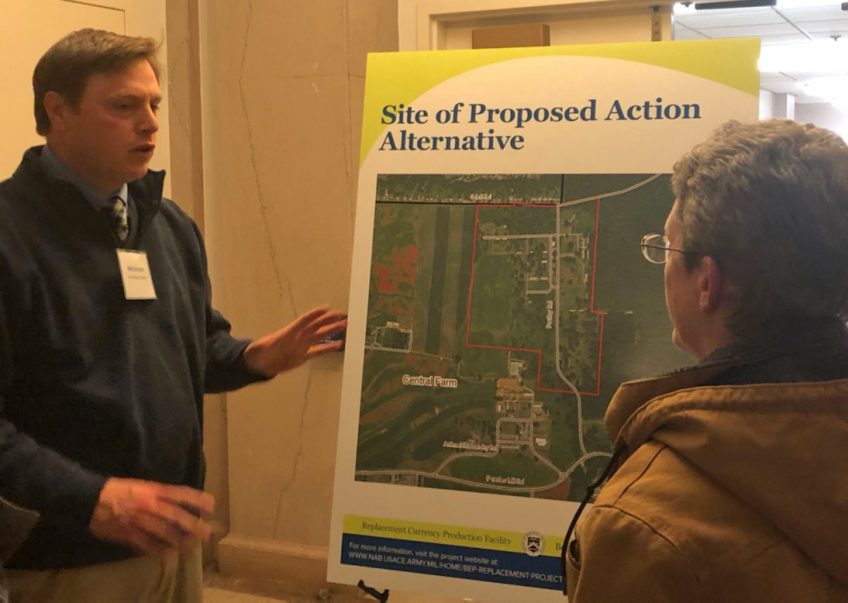An open house discussion about a proposed move of one of the Bureau of Engraving and Printing’s two production facilities from Washington, D.C., to the Beltsville Agricultural Research Center (BARC) drew skeptical comments from the public. The event was hosted by the Bureau of Engraving and Printing (BEP) and the Army Corps of Engineers from 6 to 8 p.m. on Tuesday at BARC. The Corps is coordinating the environmental studies and providing construction and design oversight for the proposal. Experts in cultural resources, traffic and transportation, and natural resources were present to answer questions. In a news release, the Corps said a move rather than an upgrade of the current BEP building, which is over 100 years old, is “the most appropriate and cost-effective option for BEP to pursue” for the facility, which is used to print U.S. paper currency. The proposed site at BARC is about 105 acres that was once used for poultry research but has been vacant since the 1990s, located at the intersection of Poultry Road and Odell Road, and approximately two miles north of the BARC upper gate on Research Road in Greenbelt’s North End. It fulfills BEP requirements that the site must be accessible to commercial airports and interstate roadways and be within a certain distance from the current site, to accommodate the existing workforce. The open house, which is a required part of the proposal process, gave the public an opportunity to learn about the proposed move and the planning process that will go into it per the National Environmental Policy Act that requires an Environmental Impact Statement (EIS). “We want them to understand what the process is,” said Harvey Johnson, the Corps program manager for this project. “People, with the information presented tonight, will understand how the process will unfold.” It also gave opportunity for the public to comment on the proposal. Greenbelt community members cited concerns about traffic, other potential for the site and especially environmental concerns. “I think it would really ruin the green space that we have,” said Jane Young. “It’d be an environmental nightmare. It wouldn’t have the dark night skies there anymore, forget all the animals that need that habitat; it would just be industrial. And there would be a lot of waste.” Marcia Van Horn agreed, saying “this site is what America is missing. The forest edge with open space and spotted trees.” She cited it as an important habitat for wildlife, specifically birds.
City Councilmember Rodney Roberts referred to the proposal as “a nightmare.” “With climate change, and trying to address that issue, there’s no way we can do this to our land and address climate change,” Roberts said. “We have to protect property like this from this kind of development. That’s what our community was about originally.” He said that the rest of council also opposes the proposal. The aforementioned news release said public comments “will be considered before any decision is made” to carry out the proposal. Some members of the public, though, were skeptical. “They don’t want comments, negative comments, obviously,” Van Horn said, saying that she hopes, but was doubtful, that those comments will be taken into account. Johnson disagreed with that sentiment. “Absolutely they will be taken into account,” Johnson said. “If there’s one thing we take away from this process today it’s that we’re encouraging people to formally submit their comments.” However, they said public concern would influence the planning process but not likely shut down the planning entirely. The next public comment period will begin with the release of the EIS draft, which is expected in summer 2021. The current public comment period ends December 15, and people can submit comments about the proposal through email to BEP-EIS@usace.army.mil or through mail, to Harvey Johnson, U.S. Army Corps of Engineers, Baltimore District Programs and Project Management Division, 2 Hopkins Plaza, 10th Floor, Baltimore, MD 21201.

